Antigen cross-presentation: proteasome location, location, location
- PMID: 31364184
- PMCID: PMC6694217
- DOI: 10.15252/embj.2019102799
Antigen cross-presentation: proteasome location, location, location
Abstract
Our understanding of the mechanisms by which peptides from proteins present in phagosomes and endosomes are processed and presented on MHC class I molecules, in a pathway called cross-presentation, is still incomplete. One of the main questions arising from currently proposed models is how do proteins in the phagosome lumen reach the proteasome in the cytoplasm to be processed properly. In this issue of The EMBO Journal, Sengupta et al (2019) present evidence for a surprising turn of events where, in fact, the proteasome acts within the lumen of endosomes and phagosomes.
© 2019 The Authors.
Figures

Comment on
-
Proteasomal degradation within endocytic organelles mediates antigen cross-presentation.EMBO J. 2019 Aug 15;38(16):e99266. doi: 10.15252/embj.201899266. Epub 2019 Jul 4. EMBO J. 2019. PMID: 31271236 Free PMC article.
References
-
- Gagnon E, Duclos S, Rondeau C, Chevet E, Cameron PH, Steele‐Mortimer O, Paiement J, Bergeron JJ, Desjardins M (2002) Endoplasmic reticulum‐mediated phagocytosis is a mechanism of entry into macrophages. Cell 110: 119–131 - PubMed
-
- Guermonprez P, Saveanu L, Kleijmeer M, Davoust J, Van Endert P, Amigorena S (2003) ER‐phagosome fusion defines an MHC class I cross‐presentation compartment in dendritic cells. Nature 425: 397–402 - PubMed
Publication types
MeSH terms
Substances
LinkOut - more resources
Full Text Sources
Research Materials

